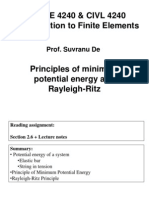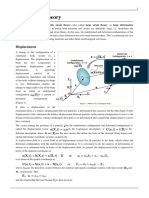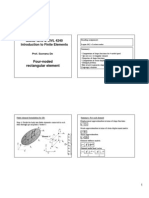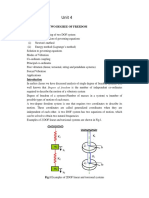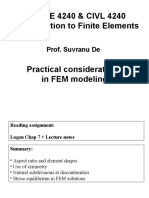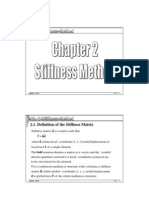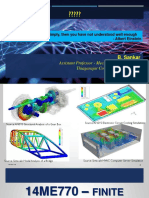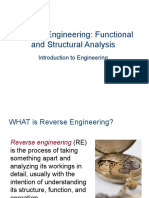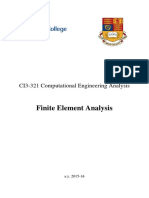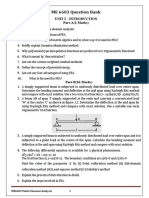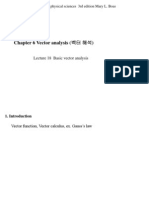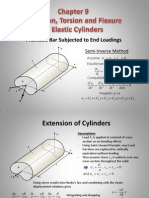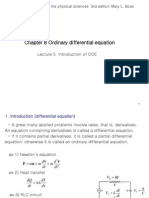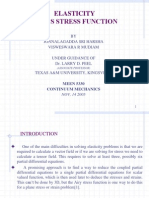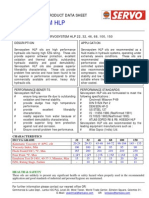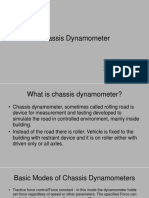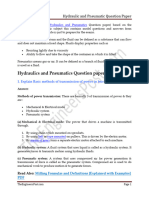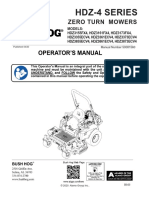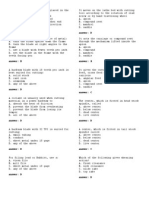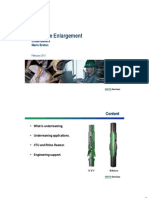Galerkin's Method in Elasticity
Galerkin's Method in Elasticity
Uploaded by
Adari SagarCopyright:
Available Formats
Galerkin's Method in Elasticity
Galerkin's Method in Elasticity
Uploaded by
Adari SagarOriginal Title
Copyright
Available Formats
Share this document
Did you find this document useful?
Is this content inappropriate?
Copyright:
Available Formats
Galerkin's Method in Elasticity
Galerkin's Method in Elasticity
Uploaded by
Adari SagarCopyright:
Available Formats
Galerkins Method in
Elasticity
In variational mechanics, we
imagine displacements to occur
when in reality no such
displacements actually exist.
These are called virtual
displacements and work
performed during these
imaginary displacements is
referred to as virtual work.
Virtual displacements are
defined such that they are
compatible with kinematic
constraints.
A necessary and sufficient
condition for the equilibrium of a
system of particles or a
continuum system is that the
work done by external forces
acting upon the system plus the
work done by the internal forces
of the system must vanish for
any virtual displacement.
The Principle of Virtual
Work Rivello
Thus we introduce a virtual
displacement field one which
satisfies our kinematic
constraints:
| = |(x)
The method always has the
form of a residual multiplied
by a weighting function. This
product is then minimized
over a domain.
For 3-D elasticity
where the terms in parens
represent residuals from the
equilibrium equations
R x
( )
|
i
dx = 0
}
co
x
cx
+
ct
xy
cy
+
ct
xz
cz
+ f
x
|
\
|
.
|
|
x
V
}
+
ct
xy
cx
+
co
y
cy
+
ct
yz
cz
+ f
y
|
\
|
.
|
|
y
+
ct
xz
cx
+
ct
yz
cy
+
co
z
cz
+ f
z
|
\
|
.
|
|
z
(
(
dV = 0
A
The | terms are virtual
displacements which satisfy
kinematic B.C.
Galerkins method dictates that
the virtual displacements take
the same form of the real
displacements which produced
the real stresses (o
x
, o
y
, o
z
, t
xy
,
t
yz
, t
zx
).
We can pick any point on the
surface of the 3-D object and
construct an outward normal n
with direction cosines n
x
, n
y
, n
z
.
n
x
n
y
n
Green-Gauss Divergence Theorem
where o(x,y,z) & u(x,y,z)
This expression allows us to rewrite
equations A as:
}
ou +
}
c
u c
o =
}
u
c
o c
s
x
V V
ds n V d
x
dV
x
( )
( )
( )
( )
T T
V V
x x y xy z xz x
s
x xy y y z yz y
x xz y yz z z z
dV fdV
n n n
n n n
n n n ds 0
o c | + | +
} }
o + t + t |
}
+ t + o + t |
(
+ t + t + o | =
B
where c(|) are virtual strains:
and on the boundaries:
and
( )
c
| c
+
c
| c
c
| c
c
| c
c
| c
= | c ,
y z
,
z
,
y
,
x
z
y
z
y
x
T
y
x z x
x y
,
x z
(
(
c
| c
+
c
| c
c
| c
+
c
| c
Surface
tractions
Point
loads
x x y xy z xz x
x xy y y z yz y
x xz y yz z z z
n n n T
n n n T
n n n T
o + t + t =
t + o + t =
t + t + o =
( )
( )
( )
x x y xy z xz x
x xy y y z yz y
x xz y yz z z z
n n n ds P
n n n ds P
n n n ds P
o + t + t =
t + o + t =
t + t + o =
which allows us to write as:
This is a mathematical statement
of the Principle of Virtual Work:
A necessary and sufficient
condition for the equilibrium of a
system of particles or a
continuum system is that the
work done by external forces
acting upon the system plus the
work done by the internal forces
of the system must vanish for any
virtual displacement.
B
o
T
c |
( )
dV
V
}
|
T
fdV
V
}
|
T
Tds
s
}
|
i
T
P
i
i
= 0
Example 1.4 (Easy Way)
( )
2
1
u 2x x u =
( )
1
u x 2 2
x
u
=
c
c
x = 1 x = 2 x = 0
2
A = 1, E = 1
x
( ) E u x 2 2
1
= o
( )
2
1
2x x | = |
( ) ( )
1
x 2 2
x
| =
c
| c
= | c
( )
T T T T
i
V V s
dV fdV Tds P 0 o c | | | | =
} } }
2 2x ( )u
1
E 2 2x ( )|
1
dxdA |
1
2 ( ) = 0
L
}
A
}
( )
2
1 1 1
L
4 8x 4x u EAdx 2 0 + | | =
}
This function
satisfies the
kinematic B.C.
0 2 EA u x
3
4
x 4 x 4
1 1 1
2
0
3 2
= | | +
2 u
3
8
1
=
u
1
=
3
4
0 2 EA u
3
8
1 1
=
|
.
|
\
|
|
1 1
The solution must be valid for all
virtual displacements, hence:
( )
2
3
u 2x x
4
=
Example 1.4 (text)
Assume we have a rod which
may have varying cross
sectional area and Youngs
modulus.
o
xx
dx
x
A
dx
x
xx
x
c
o c
+ o
dx
x
A
A
c
c
+
0 F
x
=
+
0 A dx
x
A
A dx
x
xx
xx
xx
= o
|
.
|
\
|
c
c
+
|
.
|
\
|
c
o c
+ o
0 dx
x x
A
Adx
x
dx
x
A 2
xx xx
xx
=
c c
c o c
+
c
o c
+
c
c
o
Negligible
1
Using Chain Rule
and for a rod
and so equation becomes
the equilibrium equation for a
rod!
( )
dx
dx
A d
Adx
dx
d
dx
dx
dA
xx xx
xx
o
=
o
+ o
dx
du
E E
xx xx
= c = o
1
0
dx
du
EA
dx
d
=
|
.
|
\
|
Work Example 1.2 using
Galerkins Method
Our equilibrium equation is:
If u is approximate, the
R.H.S.= 0 and = R(x), the
residual.
For Galerkins method, we
must establish
2 x @ 0 u
0 x @ 0 u
. C . B with
0
dx
du
EA
dx
d
= =
= = =
|
.
|
\
|
( ) ( ) 0 dx x R x
i
=
}
|
We select a |(x) which is
arbitrary but satisfies the
kinematic boundary conditions.
In Galerkins method, we
choose |(x) to be of the same
form as the trial function for
u(x). Thus we must evaluate:
Let U = |(x) so
Symbolically we integrate by
parts using:
( )
}
=
|
.
|
\
|
| 0 dx
dx
du
EA
dx
d
x
dU
d
dx
|
=
|
.
|
\
|
=
dx
du
EA
dx
d
dv
dx
du
EA v =
dv v v U U dU =
} }
Substituting yields:
In Example 1.2, we let
so
Recognize the is equal
to the axial load in the rod
which for our problem is of
the form:
EA
du
dx
|
\
|
.
|
0
2
EA
du
dx
d|
dx
dx = 0
}
2
( )
2
1
u 2x x u =
( )
2
1
2x x | = |
dx
du
EA
so the first term must be evaluated in
two parts:
but |
0
and |
2
must = 0 since | must
satisfy kinematic B.C.
Substituting this and u and | and E =
A = 1 into yields:
2
1
1
0
2
0
dx
du
EA
dx
du
EA
dx
du
EA | + | = |
|
.
|
\
|
= |
1
-1
( )
|
0
-1
( )
| |
+
|
2
- 1 ( ) |
1
- 1 ( )
| |
2
(+1)
(-1)
x = 0 x = 1 x = 2
T
x
EA
du
dx
|
\
|
.
|
0
2
= 2|
1
or
which must be true for all
virtual displacements | so
and
( ) 0 2 dx x 2 2 u
2
0
2
1 1
=
(
}
+ |
0 2 u
3
8
1 1
=
|
.
|
\
|
+ |
u
1
= .75
( )
2
u .75 2x x =
Clarification of Galerkins
Method
Simplifying we have:
+
0 F
x
o
xx
+
co
xx
cx
dx
|
\
|
.
A +
cA
cx
dx
|
\
|
.
o
xx
A
0 Adx f dx T
x x
= + +
d
dx
EA
du
dx
|
\
|
.
dx + T
x
dx + f
x
Adx = 0
o
xx
dx
x
A
dx
x
xx
xx
c
o c
+ o
dx
x
A
A
c
c
+
T
x
f
x
This is the equilibrium
equation for a rod with surface
traction and body forces. It is
also our residual equation for
Galerkins method.
Integration by parts of the first
term yields:
R x
( )
| x
( )
dx = 0
}
A
d
dx
EA
du
dx
|
\
|
.
| x
( )
dx + T
x
| x
( )
} }
dx
+ f
x
A| x
( )
dx = 0
}
EA
du
dx
|
\
|
.
| EA
du
dx
d|
dx
dx
}
Upon substitution into A we have
which is equivalent to
Should you use equations A or B in
the solution of your homework
problems? The answer is that the
two expressions are equivalent and
therefore it does not matter. I like to
use the B form since it is so similar
to the Total Potential expression H.
( ) ( )
x x
du d
EA dx f A x dx T x dx
dx dx
du
EA 0
dx
|
| |
} } }
| |
| =
|
\ .
o
T
c | ( )dV
V
}
|
T
fdV
V
}
|
T
Tds
s
}
= |
i
T
0 P B
Galerkins Method for Beams
Virtual Work
Real Stresses:
Virtual Strains:
Thus:
but
o
T
c |
( )
dV
V
}
|
T
fdV
V
}
|
T
Tds
s
}
|
i
T
P
i
i
= 0
o
x
=
My
I
c
x
| ( ) =
M | ( )y
EI
o
T
c | ( )dV
V
}
=
M
EI
M | ( )
EI
Ey
2
A
}
dAdx
L
}
v
' '
=
M
EI
and |
' '
=
M | ( )
EI
EIv
"
|
"
dx
L
}
|
T
fdV
V
}
|
T
Tds
s
}
|
i
T
P
i
i
= 0
so:
Galerkins Method Example
Recall our earlier example
1. Select a form of deformation.
2. Is this form compatible with
kinematic boundary
conditions?
L
x
W
( ) e dx cx bx ax x v
2 3 4
+ + + + =
Kinematic B.C.
Our trial function is:
( ) 0 e if only 0
?
0 v = =
( ) 0
?
0 ' v
=
( )
0 d if only
d cx 2 bx 3 ax 4 x ' v
2 3
=
+ + + =
( )
( )
4 3 2
3 2
2
v(x) ax bx cx
v' x 4ax 3bx 2cx
v" x 12ax 6bx 2c
= + +
= + +
= + +
Thus the virtual displacement is:
and the virtual curvature is:
So the virtual work of internal
forces is:
( )
4 3 2
1 2 3
x x x x | = | +| +|
( )
" 2
1 2 3
x 12x 6x 2 | = | + | + |
( )
( )
" "
L
5 4 3
1
4 3 2
2
3 2
3
EIv dx
144
EI aL 18bL 8cL
5
EI 18aL 12bL 6cL
EI 8aL 6bL 4cL
| =
}
| |
+ + | +
|
\ .
+ + | +
+ + |
The virtual work of external forces is:
Thus the total virtual work:
becomes:
|
1,
|
2
and |
3
are arbitrary and thus the terms
that premultiply them must be zero to
force the virtual work to vanish.
5 4 3
T
1 2 3
L
WL WL WL
Tdx
5 4 3
| = | | |
}
EIv
"
|
"
dx
L
}
|
T
fdV
V
}
|
T
Tds
s
}
|
i
T
P
i
i
= 0
( )
( )
5
5 4 3
1
4
4 3 2
2
3
3 2
3
144 WL
EI aL 18bL 8cL
5 5
WL
EI 18aL 12bL 6cL
4
WL
EI 8aL 6bL 4cL 0
3
(
| |
+ + | +
(
|
\ .
(
(
+ + | +
(
(
(
+ + | =
(
(
Thus we obtain 3 equations with
which we can solve for the 3
unknowns a,b, and c:
Solving yields:
Substituting into the trial function:
which turns out to be exact!
5
5 4 3
144 WL
EI aL 18bL 8cL 0
5 5
| |
+ + =
|
\ .
( )
4
4 3 2
WL
EI 18aL 12bL 6cL 0
4
+ + =
2
W WL WL
a b c
24EI 6EI 4EI
= = =
( )
2
4 3 2
W WL WL
v x x x x
24EI 6EI 4EI
= +
( )
3
3 2
WL
EI 8aL 6bL 4cL 0
3
+ + =
Chapter 1 - Summary
Energy Method
Form the total potential.
}
}
c o = H
V
T
V
T
fdV u dV
2
1
}
i
i
i
T
i
T
P u Tds u
For a
rod
For a
beam
For a
spring
}
|
.
|
\
|
c
c
L
2
dx
x
u
EA
2
1
}
|
|
.
|
\
|
c
c
L
2
2
2
dx
x
v
EI
2
1
2
K
2
1
o
1. Choose a trial function for u
or v.
2. Ensure the function satisfies
kinematic B.C.
3. Form the work potential
terms per the trial function.
4. Use the Theory of
Minimum Total Potential.
Minimize the H W.R.T. to
each unknown coefficient in
your trial function. This will
generate n equations for n
unknown coefficients.
5. Solve for the coefficients.
Procedure
Galerkins Method
Always has the form:
General form for all problems:
For 1-D rod problems (w/o tractions or
body forces) A can be written:
For beam problems A can be written:
I would suggest always employing the
general form to reduce confusion.
}
= | 0 dV R
( )
= |
}
|
}
|
}
| c o
0 P
Tds fdV dV
T
s
T
V
T
V
T
A
T T T
x
x V s
d du
E Adx fdV Tds P 0
dx dx
|
=
} } }
EIv
"
|
"
dx
L
}
|
T
fdV
V
}
|
T
Tds
s
}
|
i
T
P
i
i
= 0
1. Choose a trial function.
v or u = A*f(x) + B*g(x)+
2. Ensure the function(s) satisfy
kinematic B.C.
3. Choose the virtual displacements to
be of the form of the trial function:
4. Substitute into the general form and
integrate to yield the virtual work.
5. Remember the virtual displacements
|
1
, |
2
, etc. are arbitrary. Collect the
group of terms which premultiply the
virtual displacements. Force each
group of terms to vanish which will
yield as many equations as you have
unknowns in your real trial function.
6. Solve for the unknowns A, B,
( ) ( )
1 2
f x g x ...... | = | + | +
Procedure
You might also like
- Minimum Potential Energy PrincipleDocument29 pagesMinimum Potential Energy Principlemahesh84psgNo ratings yet
- DictionaryGerman To EnglishDocument597 pagesDictionaryGerman To EnglishCarlos Leonardo Rojas Campiño100% (4)
- TD1005 Free and Forced Convection Datasheet 0518 PDFDocument3 pagesTD1005 Free and Forced Convection Datasheet 0518 PDFAmier AziziNo ratings yet
- Lesson 5 For AeronauticalDocument28 pagesLesson 5 For AeronauticalprannenbatraNo ratings yet
- 3.1 3.7 Equations of MotionDocument35 pages3.1 3.7 Equations of MotionNinja Warrior GamerNo ratings yet
- FEM L1 (C)Document27 pagesFEM L1 (C)zinilNo ratings yet
- Deformation PDFDocument66 pagesDeformation PDFRicardo ColosimoNo ratings yet
- 7 - More SUVAT Equations and RevisionDocument31 pages7 - More SUVAT Equations and RevisionAliNo ratings yet
- Finite Element Formulation For Plates PDFDocument20 pagesFinite Element Formulation For Plates PDFnayak_yellappaNo ratings yet
- 3-d ElasticityDocument40 pages3-d Elasticityp_sahoo8686No ratings yet
- Fundamentals For Finite Element MethodDocument34 pagesFundamentals For Finite Element MethodnaderNo ratings yet
- Introduction To The Stiffness (Displacement) Method: Analysis of A System of SpringsDocument43 pagesIntroduction To The Stiffness (Displacement) Method: Analysis of A System of SpringsmmgaribayNo ratings yet
- Finite Strain TheoryDocument19 pagesFinite Strain TheorySnehasish BhattacharjeeNo ratings yet
- MANE 4240 & CIVL 4240 Introduction To Finite Elements: Prof. Suvranu deDocument28 pagesMANE 4240 & CIVL 4240 Introduction To Finite Elements: Prof. Suvranu deskkskNo ratings yet
- A FEM IntroductionDocument18 pagesA FEM IntroductionAnonymous Bdt0OGh100% (1)
- Weighted Residual FormulationsDocument5 pagesWeighted Residual FormulationsAhmed ShawkyNo ratings yet
- 4 Node QuadDocument7 pages4 Node QuadSachin KudteNo ratings yet
- Module 5: Two Dimensional Problems in Cartesian Coordinate SystemDocument7 pagesModule 5: Two Dimensional Problems in Cartesian Coordinate Systemakhlaq_hssainkotaNo ratings yet
- Seminar Report 5nov2013Document22 pagesSeminar Report 5nov2013ram_shyam2621No ratings yet
- Finite Element Method: Mechanical Engineering DepartmentDocument27 pagesFinite Element Method: Mechanical Engineering DepartmentmNo ratings yet
- Finite Elements For The (Navier) Stokes EquationsDocument61 pagesFinite Elements For The (Navier) Stokes EquationschrissbansNo ratings yet
- 2 DOF NotesDocument35 pages2 DOF Noteslebron jamesNo ratings yet
- Chapter 4 Multiple Degree of Freedom SystemsDocument89 pagesChapter 4 Multiple Degree of Freedom SystemsTom LaNo ratings yet
- MANE 4240 & CIVL 4240 Introduction To Finite Elements: Prof. Suvranu deDocument30 pagesMANE 4240 & CIVL 4240 Introduction To Finite Elements: Prof. Suvranu deIsrar UllahNo ratings yet
- Fea QBDocument11 pagesFea QBPradeepNo ratings yet
- FEM Higher Order ElementsDocument28 pagesFEM Higher Order Elementsjoshibec100% (1)
- Introduction About Finite Element AnalysisDocument19 pagesIntroduction About Finite Element AnalysisSabareeswaran MurugesanNo ratings yet
- CH 2 Stiffness Method 09Document22 pagesCH 2 Stiffness Method 09Syahrianto Saputra100% (1)
- Advanced Strength of Materials Paper ModelDocument3 pagesAdvanced Strength of Materials Paper ModeldurgaraokamireddyNo ratings yet
- Finite Element Method (AAE 3202) RCSDocument3 pagesFinite Element Method (AAE 3202) RCSSagar AchNo ratings yet
- 4 Node QuadDocument27 pages4 Node QuadMathiew EstephoNo ratings yet
- Cantilever Beam TutorialDocument7 pagesCantilever Beam TutorialMohammad Ahmad GharaibehNo ratings yet
- Constant Strain Triangle - Stiffness Matrix DerivationDocument33 pagesConstant Strain Triangle - Stiffness Matrix DerivationM.Saravana Kumar..M.ENo ratings yet
- Finite Element Analysis Simply Explained: T. C. Kennedy Oregon State University July 2016Document23 pagesFinite Element Analysis Simply Explained: T. C. Kennedy Oregon State University July 2016Jitendra ItankarNo ratings yet
- Newton-Raphson MethodDocument32 pagesNewton-Raphson MethodnafisbadranNo ratings yet
- 3D Stress Components: Normal StressesDocument71 pages3D Stress Components: Normal Stressesengr_usman04No ratings yet
- Fem 1Document49 pagesFem 1Asim ZulfiqarNo ratings yet
- PDF 5Document17 pagesPDF 5James BundNo ratings yet
- ME2353 Finite Element Analysis Lecture NotesDocument34 pagesME2353 Finite Element Analysis Lecture Notespgkaero100% (2)
- Formula Sheet UpdatedDocument10 pagesFormula Sheet UpdatedSania BatoolNo ratings yet
- Ch5 Method of Weighted ResidualsDocument38 pagesCh5 Method of Weighted ResidualsWaleed TayyabNo ratings yet
- C E D C A E: Ollege of Ngineering Epartment of Ivil & Rchitectural NgineeringDocument27 pagesC E D C A E: Ollege of Ngineering Epartment of Ivil & Rchitectural Ngineeringhend mahmoudNo ratings yet
- 14ME770 - Finite Element AnalysisDocument34 pages14ME770 - Finite Element Analysissaravana pandianNo ratings yet
- ME2353 Finite Element Analysis Lecture NotesDocument34 pagesME2353 Finite Element Analysis Lecture NoteschinnaNo ratings yet
- FEM CIE 2 Question BankDocument8 pagesFEM CIE 2 Question BankFOODIE USNo ratings yet
- 7.weighted Residual Methods Galerkin - English - 2022Document36 pages7.weighted Residual Methods Galerkin - English - 2022Pavlos YioukkasNo ratings yet
- Rayleigh Ritz MethodDocument19 pagesRayleigh Ritz MethodMohit VatsNo ratings yet
- Reverse Engineering: Functional and Structural AnalysisDocument40 pagesReverse Engineering: Functional and Structural AnalysisAmirul RoslanNo ratings yet
- Introduction Finite Element MethodDocument31 pagesIntroduction Finite Element MethodAgus SaefudinNo ratings yet
- Midterm VibrationsDocument18 pagesMidterm VibrationsAravind KumarNo ratings yet
- FEA Question BankDocument6 pagesFEA Question Bankmenmoli2012No ratings yet
- Dynamic Analysis FEMDocument9 pagesDynamic Analysis FEMbhanuNo ratings yet
- Finite Elements (Notes) 2015-16Document32 pagesFinite Elements (Notes) 2015-16yangshaoweiNo ratings yet
- Fea Unit Wise Imp - FormulaeDocument18 pagesFea Unit Wise Imp - FormulaeS A ABDUL SUKKUR100% (1)
- ME 6603 Question Bank: Unit I - Introduction Part-A (2-Marks)Document6 pagesME 6603 Question Bank: Unit I - Introduction Part-A (2-Marks)Bharathi KannaNo ratings yet
- Damage Mechanics in Metal Forming: Advanced Modeling and Numerical SimulationFrom EverandDamage Mechanics in Metal Forming: Advanced Modeling and Numerical SimulationRating: 4 out of 5 stars4/5 (1)
- Vector AnalysisDocument72 pagesVector AnalysisAileenMTNo ratings yet
- Integration Key FactsDocument7 pagesIntegration Key FactsLauren BuxtonNo ratings yet
- Integration PDFDocument11 pagesIntegration PDFJaymour Cris FiestaNo ratings yet
- Torsion of BarsDocument33 pagesTorsion of Barskrishna kumar100% (1)
- Ordinary Differential EquationDocument73 pagesOrdinary Differential EquationWahyu SutrisnoNo ratings yet
- Misrimal Navajee Munoth Jain Engineering College, Chennai - 97Document22 pagesMisrimal Navajee Munoth Jain Engineering College, Chennai - 97Vishnu Krishna KumarNo ratings yet
- Elasticity AiryStressDocument19 pagesElasticity AiryStressAdari SagarNo ratings yet
- Referee ApplicationDocument2 pagesReferee ApplicationAdari SagarNo ratings yet
- Fatigue Crack GrowthDocument38 pagesFatigue Crack GrowthKarthi KeyanNo ratings yet
- Fe Exam TipsDocument31 pagesFe Exam TipsAdari Sagar100% (1)
- Servosystem HLPDocument1 pageServosystem HLPAdari SagarNo ratings yet
- CNG A4-EngDocument8 pagesCNG A4-EngЭльмар ГафаровNo ratings yet
- QCS 2014-CalorifiersDocument4 pagesQCS 2014-CalorifiersAfnanMuhammadNo ratings yet
- Boiler BurnersDocument8 pagesBoiler BurnersAnoop VijayakumarNo ratings yet
- Presentation On Chasis DynamometerDocument22 pagesPresentation On Chasis DynamometerAjay_BadeNo ratings yet
- Harmonic Analysis REV. 1Document7 pagesHarmonic Analysis REV. 1Amro SalahNo ratings yet
- Simulator List For IB PhysicsDocument7 pagesSimulator List For IB PhysicsBhavika ChoudharyNo ratings yet
- Liquified Nat Gas STD FRP ReferenceDocument33 pagesLiquified Nat Gas STD FRP ReferenceAriel HughesNo ratings yet
- Metering Pump SekoDocument40 pagesMetering Pump SekoOnie Hammamz OylNo ratings yet
- Fisher R EDR and ETR Easy Et Valves: Scope of ManualDocument24 pagesFisher R EDR and ETR Easy Et Valves: Scope of ManualPratik SinghNo ratings yet
- Foundation of Computational Fluid Dynamics Dr. S. Vengadesan Department of Applied Mechanics Indian Institute of Technology, Madras Lecture - 02Document19 pagesFoundation of Computational Fluid Dynamics Dr. S. Vengadesan Department of Applied Mechanics Indian Institute of Technology, Madras Lecture - 02Shahzaib Anwar OffNo ratings yet
- Gate Valve Standard FeaturesDocument3 pagesGate Valve Standard Featuresعزت عبد المنعمNo ratings yet
- Atlas Copco Xrvs 476 Manual PDFDocument104 pagesAtlas Copco Xrvs 476 Manual PDFpowermanagerNo ratings yet
- Swab CupsDocument2 pagesSwab CupsRobertoVitorianoNo ratings yet
- Tr4085 Drive Axle Design Group 7Document56 pagesTr4085 Drive Axle Design Group 7Hoàng LongNo ratings yet
- Hydraulic and Pneumatic Question PaperDocument24 pagesHydraulic and Pneumatic Question PaperAbdihamid bin-mohamoudNo ratings yet
- Theory-Manual Eng 2011 PDFDocument119 pagesTheory-Manual Eng 2011 PDFErisvaldo de LimaNo ratings yet
- OP MANUAL - HDZ 4 - Pub 04 20Document104 pagesOP MANUAL - HDZ 4 - Pub 04 20James LoewenNo ratings yet
- 01,02 Cable and Tube ListDocument7 pages01,02 Cable and Tube ListLê VươngNo ratings yet
- Answer: A Answer: DDocument16 pagesAnswer: A Answer: DAriel Mark Pilotin100% (1)
- Wellbore Enlargement DPA RioDocument19 pagesWellbore Enlargement DPA RioAdriana RezendeNo ratings yet
- Baja Silueta Serie M BGHDocument99 pagesBaja Silueta Serie M BGHFernando Pelinski100% (1)
- FAIRCHILD T6000 Electro-Pneumatic Transducers Standard and Extended Ranges Installation InstructionsDocument4 pagesFAIRCHILD T6000 Electro-Pneumatic Transducers Standard and Extended Ranges Installation InstructionsALEJANDRO IPATZINo ratings yet
- Part-A: Instructions: 1. Answer ALL Questions 04 X 01 04 2 Each Question Carries ONE MarkDocument7 pagesPart-A: Instructions: 1. Answer ALL Questions 04 X 01 04 2 Each Question Carries ONE MarkDonNo ratings yet
- Brake System of Semi TrailerDocument18 pagesBrake System of Semi TrailerVăn HưngNo ratings yet
- Base-Isolation Design Practice in Japan Introduction To The Post-Kobe ApproachDocument26 pagesBase-Isolation Design Practice in Japan Introduction To The Post-Kobe ApproachSoheil RamezaniNo ratings yet
- Branch Connection Fittings (MSS SP-97) - Weldolet®, Sockolet®, Thredolet®, Latrolet®, Elbolet®, Nipolet®, Sweepolet®Document3 pagesBranch Connection Fittings (MSS SP-97) - Weldolet®, Sockolet®, Thredolet®, Latrolet®, Elbolet®, Nipolet®, Sweepolet®dchz_62100% (1)
- Assignment 1: Modelling The Stress-Strain Behavior of Soils: Part A (5 Marks)Document4 pagesAssignment 1: Modelling The Stress-Strain Behavior of Soils: Part A (5 Marks)Jasper FridamanNo ratings yet
- M2 - U3 - Manual Metal Arc Welding PDFDocument34 pagesM2 - U3 - Manual Metal Arc Welding PDFSureshNo ratings yet
